Runners and cyclists alike are no strangers to the sensation of a sharp pain on the outside of the knee. This is the hallmark of Iliotibial Band Syndrome.
Biking and running are the two main activities that can trigger IT band syndrome. Read more about Iliotibial Band Syndrome
The IT band is a strip of fibrous tissue that runs from the hip, down the outer thigh, to the outside of the knee. Experts have a few theories exactly why it becomes irritated and painful, but the main symptom it causes is sharp pain on the outside of the knee.
This pain is usually worse as the foot strikes the ground for runners or on the down-pedal for bikers; it can also be worse when the knee is at a 30-degree angle. In addition to pain, IT band syndrome can cause tenderness and loss of range of motion.
If you're experiencing knee pain from IT band syndrome, you may not realize that your training choices may in fact be triggering your IT band problems.
These 8 training habits can all contribute to IT band syndrome:
-
Wearing the wrong shoes.
Shoes can make a lot of difference in how much stress radiates up your legs when your feet strike the ground, especially if the shoes are overworn. Replace worn out shoes or switch to shoes with more support to resolve or improve IT band pain. -
Adjusting your bike seat incorrectly.
Bike seats that are too high can cause excessive leg extension, which can aggravate the IT band. -
Not strengthening your hip and thigh muscles.
Weak thigh muscle groups such as the hamstrings (back of thighs) or hip adductors (inner thighs) can cause the IT band to tighten. Make sure to do strengthening exercises for these muscle groups—and stretch them out after exercising. -
Not warming up.
Muscles benefit from 5 to 10 minutes of moderate warm-up exercise before you jump into your full workout. -
Running on hard or uneven surfaces.
To lessen IT band problems, try switching running surfaces from concrete to dirt or a padded running track. -
Biking in too high a gear.
The added resistance of higher gears can trigger IT band pain. Try a lower, easier gear, even if it increases your RPMs. -
Ramping up your training too quickly. IT band syndrome is an overuse injury, which means it can be triggered by workouts that increase in length or intensity too quickly. If your training regimen is causing IT band pain, ease off your pace of training and/or cross-train more.
-
Running with poor form.
Sometimes the biomechanics of your running technique can contribute to IT band syndrome. If you're having IT band pain and you've tried correcting the training habits listed above without relief, consider having a professional conduct a gait analysis of your running style for you.
In addition to correcting training errors, there are a 2 simple tactics that can treat the pain of IT band syndrome:
-
Rest. For runners or cyclists who are striving to achieve goals or train for an event, it can be stressful to take a break and step away from activity. But sometimes this is what the body needs to heal and restore the IT band.
-
Foam rolling. Using a foam roller on the outside of your thigh can be very painful but also very effective in easing a tight IT band. Learn more about using a foam roller with this beginner's guide to foam rolling.
For severe cases of IT band syndrome, your doctor may recommend more invasive treatment options such as injections or surgery.











